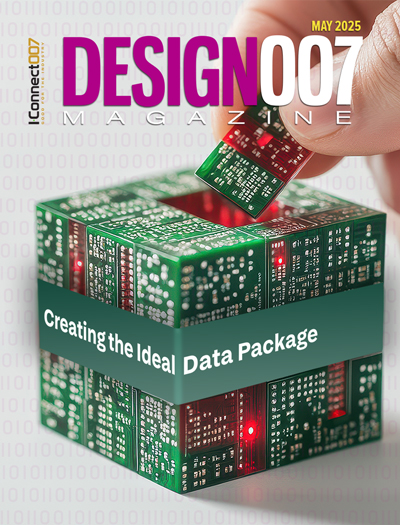-

- News
- Books
Featured Books
- design007 Magazine
Latest Issues
Current Issue
Creating the Ideal Data Package
Why is it so difficult to create the ideal data package? Many of these simple errors can be alleviated by paying attention to detail—and knowing what issues to look out for. So, this month, our experts weigh in on the best practices for creating the ideal design data package for your design.

Designing Through the Noise
Our experts discuss the constantly evolving world of RF design, including the many tradeoffs, material considerations, and design tips and techniques that designers and design engineers need to know to succeed in this high-frequency realm.

Learning to Speak ‘Fab’
Our expert contributors clear up many of the miscommunication problems between PCB designers and their fab and assembly stakeholders. As you will see, a little extra planning early in the design cycle can go a long way toward maintaining open lines of communication with the fab and assembly folks.
- Articles
- Columns
Search Console
- Links
- Media kit
||| MENU - design007 Magazine
BOOK EXCERPT: The Printed Circuit Designer’s Guide to... DFM Essentials, Chapter 2
November 14, 2024 | I-Connect007 Editorial TeamEstimated reading time: 1 minute
The Printed Circuit Designer’s Guide to... DFM Essentials
by Anaya Vardya, American Standard Circuits / ASC Sunstone Circuits
Chapter 2: Panelization
Panelization is the process of placing one or more PCBs on a manufacturing panel and incorporating features to assist manufacturing (such as tooling holes, fiducials, coupons, panel thieving, etc.). Panelization is one of the highest impact factors in the cost of a PCB.
The panel area available for circuit boards plus coupons is known as the usable area (Figure 2.1). Test coupons are added by the fabricator to the perimeter of the manufacturing panel outside the usable area. The number and type of coupons are based on the specs that the PCBs are being built to and requirements for controlled impedance. Coupons may sometimes further reduce the amount of a PCB panel that is available for the circuit boards. This is defined by the fabricator as required perimeter for coupons. This is typically about 1 inch or 25.4 mm and is a fixed area based on panel size. Panel utilization is measured as a percentage, defined by the total area for PCBs divided by the total panel area.
Cost-effective material utilization is defined by a target panel with greater than 75% panel utilization. Raw laminate is one of the primary cost constituents of a multilayer PCB. Optimizing panel structures around standard base materials while achieving maximum material utilization on one of the standard panel sizes can have a significant impact on multilayer board prices and deliveries. The three most preferred sizes in North America are 12x18 inches, 18x24 inches and 21x24 inches, with 18x24 inches being the most common. For special applications, other panel sizes can be provided. In Asia, typically the shops will process custom panel sizes in order to maximize utilization. The most effective cost per unit area processed is usually found with a larger panel size.
Visit the I-Connect007 library to continue reading The Printed Circuit Designer’s Guide to DFM Essentials.
Suggested Items
Japan’s Sharp to Sell LCD Plant to Taiwanese Parent Company Foxconn
05/14/2025 | I-Connect007Japanese electronics firm Sharp Corp. announced on May 12 that it plans to sell its Kameyama No. 2 liquid crystal display plant to its Taiwanese parent company, Foxconn.
Panel Driver IC Price Decline Slows in 1H25; Gold Prices, China Subsidies, and U.S.-China Tariffs Emerge as Key Variables
04/28/2025 | TrendForceTrendForce’s latest investigation finds that China’s subsidy policies and rising concerns over reciprocal tariffs are reshaping brand strategies in the panel market, indirectly influencing price trends for panel driver ICs.
Tandem Panel Shipments to Jump Again to 36% in 2026
04/25/2025 | BUSINESS WIREAccording to recent display industry research from Omdia, tandem RGB penetration into the OLED tablet and notebook panel markets surged from almost zero to more than 30% in 2024.
QD-OLED to Account for 73% of OLED Monitor Shipments in 2025, Driven by Advancing Technology and New Products
04/16/2025 | TrendForceTrendForce’s latest investigations reveal that ongoing advancements in OLED displays are propelling the growth of QD-OLED monitor shipments. QD-OLED’s share of OLED monitor shipments is expected to rise from 68% in 2024 to 73% in 2025, highlighting its strong competitiveness in the high-end monitor market.
Tariff Uncertainty Weighs on Display Demand, Pricing, and the Supply of AMOLED Materials,
04/09/2025 | TrendForceTrendForce reports that the U.S. began implementing reciprocal tariffs on April 9th, based largely on trade deficits. Consequently, Asia—particularly Southeast Asia, a key hub for the consumer electronics supply chain—has been significantly impacted.


